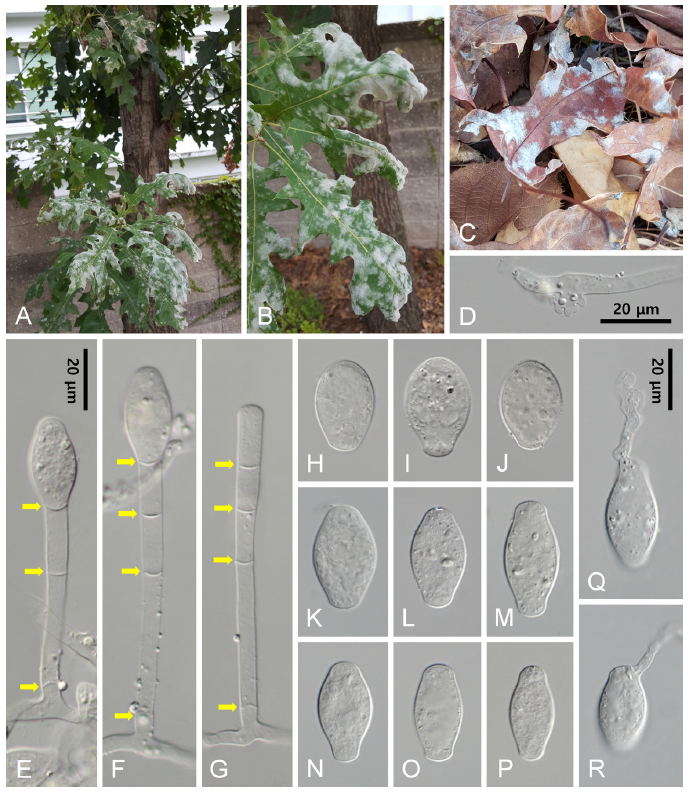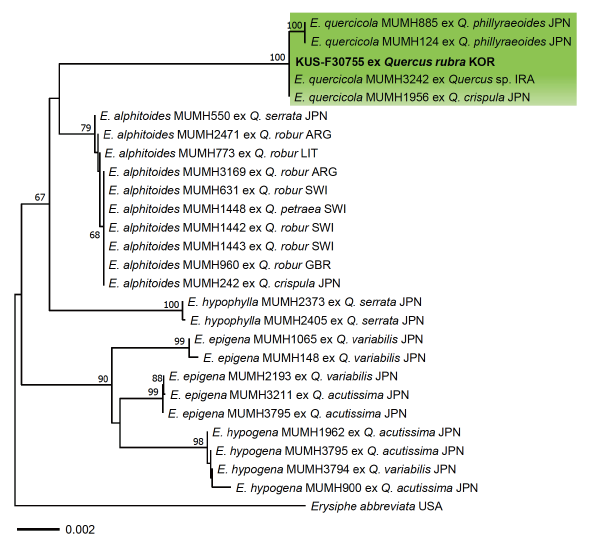Quercus rubra L., commonly called the northern red oak, is native to North America and is cultivated as an ornamental tree in temperate regions. It is widely grown in parks and gardens in Korea. August 2018, powdery mildew was observed on several Q. rubra trees in a public garden in Seoul, South Korea. White superficial fungal colonies were present on both sides of the leaves and young shoots (Fig. 1A). Severe infections often caused malformation and necrotic discoloration of the leaves (Fig. 1B). No chasmothecia were observed until the infected leaves dropped and dried in December (Fig. 1C).
For morphological examination, anamorphic structures were detached from the powdery mildew colonies on fresh leaves of the plant using a sterile razor blade, mounted in distilled water, and examined using bright-field and differential interference contrast (DIC) light microscopy (Carl Zeiss, Oberkochen, Germany). At least 20 measurements were performed for each morphological structure. Dried herbarium samples were analyzed using the lactic acid technique [1]. Two voucher specimens were deposited at the Korea University Herbarium in Seoul, Korea, under accession numbers KUS-F30755 and F30867.
The morphological characteristics of the fresh samples were as follows: The hyphae were septate, branched, and 4-8 µm in width. Hyphal appressoria were multilobed to moderately lobed, single or in pairs, and 4-7 µm wide (Fig. 1D). Conidiophores were 3-4-celled, cylindrical, 56-98×7-9 µm in size, and produced conidia singly (Fig. 1E-G). Foot cells of conidiophores were cylindrical, straight, or slightly flexuous at the base and 24-46 µm long, with a basal septum at 6-12 µm away from the branching point of the mycelium. Conidia were ellipsoid or doliiform, 25-38×18-24 µm with a length/width ratio of 1.5-1.9 and devoid of distinct fibrosin bodies (Fig. 1K-P). The primary conidia were apically round and basally sub-truncated (Fig. 1H-J). Germ tubes were formed on the perihilar position of the conidia (Fig. 1Q-R). The structure and measurements were consistent with the anamorphic features of Erysiphe quercicola S. Takam. & U. Braun [2,3].

Fig. 1.Erysiphe quercicola causing powdery mildew on Quercus rubra. A: Affected tree showing powdery mildew symptoms. B: Close-up of affected leaves. C: Fallen leaves with powdery mildew symptoms. D: Appressoria on a hypha. E-G: Conidiophores. Arrows indicate septa. H-J: Primary conidia. K-P: Conidia. Q-R: Germinating conidia.
For molecular analysis, genomic DNA was extracted from conidia and mycelia harvested from the infected leaves of KUS-F30755 using a MagListo 5 M plant Genomic DNA Extraction Kit (Bioneer, Daejeon, Korea). The nucleotide sequences of the internal transcribed spacer (ITS) and 28S rDNA regions were amplified using primer pairs PM10/ITS4 and PM3/TW14, respectively, under the PCR conditions outlined by Bradshaw and Tobin [4]. The PCR products were purified using an AccuPrep PCR Purification Kit (Bioneer) and sequenced by Macrogen Inc. (Seoul, Korea). The resulting sequences were edited using the DNAStar software package (Madison, Wis., USA) version 5.05 and deposited in GenBank (Accession nos. OM899628 and OM899630). A BLASTn search was conducted to investigate sequence similarities with reference sequences in NCBI GenBank. The sequences of individual markers, including the reference sequences of Erysiphe species originating from Quercus spp. retrieved from GenBank, were aligned using MAFFT 7 [5] and concatenated in SequenceMatrix v1.7.8 [6]. A phylogenetic tree of the concatenated alignment was constructed by the minimum evolution (ME) method using MEGA X [7] with the default settings of the program, except by using the Tamura-Nei model instead of the maximum composite likelihood model. The robustness of the phylogenetic tree was evaluated using 1,000 bootstrap (BS) replicates.
Based on a BLASTn search of the NCBI GenBank, the Korean specimen showed 100% sequence similarity (668/668 bp) with the reference sequences of E. quercicola (AB193607, AB237808, AB292693, LC270856, MH333267) for ITS and 99.9-100% (997 or 998/998 bp) similarity with those of E. quercicola (AB292692, MN1659866-7, LC128423-5) for LSU sequences. ME analyses of a concatenated alignment of ITS and LSU sequences were performed to infer the phylogenetic relationships between the Korean specimen and previously identified Erysiphe species parasitic on Quercus spp. The phylogenetic tree (Fig. 2) revealed that the Korean specimens grouped with the reference sequences of E. quercicola, parasitic on Q. crispula, Q. phillyraeoides, and Q. serrata, with the maximum bootstrapping value, but were distantly related to the other four species of Erysiphe parasitic on Quercus species, namely, E. alphitoides, E. epigena, E. hypogena, and E. hypophylla.

Fig. 2.Phylogenetic tree of Erysiphe species from the minimum evolution analysis based on a concatenated alignment of the internal transcribed spacer (ITS) and large subunit (LSU) of rDNA sequences. Bootstrap values higher than 60% are shown above the branches (1,000 replicates). The green box covers the sequences of Erysiphe quercicola and Korean isolates obtained from Quercus rubra are displayed in bold. The scale bar indicates the number of nucleotide substitutions per site.
A literature review showed that two species of Erysiphe (including formerly Microsphaera) have been recorded as powdery mildews on Q. rubra [8]. Erysiphe alphitoides complex has been described in Europe (Czechoslovakia, France, Germany, Lithuania, Netherlands, Poland, Romania, Russia, Serbia, Switzerland, and the United Kingdom) and Korea. However, the record of E. alphitoides on Q. rubra in Korea is erroneous because of the misidentification of the host plant. Erysiphe extensa var. extensa has been recorded in the United States (Missouri, New York, and Wisconsin) [3]. In conclusion, the E. alphitoides complex from Europe and E. extensa var. extensa from the United States were recorded for Q. rubra.
Recently, the E. alphitoides complex has been divided into several distinct species including E. quercicola [2,3,9]. Therefore, the identity of E. alphitoides on Q. rubra in European countries remains obscure. The observation of E. quercicola in Korea provides the first report of powdery mildew on Q. rubra in Asia. Two hypotheses can be put forward regarding this finding. One possibility is a biological invasion of the European isolate into East Asia, and another is the host expansion of the Korean isolate from the native Quercus spp. to the introduced Q. rubra. Erysiphe quercicola is one of the most common powdery mildew species on native Quercus spp. [10,11] and introduced Q. robur in Korea [12]. This is the first confirmed report on the identity of powdery mildew found on Q. rubra in Korea. This finding would be useful to understand the host expansion of E. quercicola and the biodiversity of powdery mildews on Quercus species.




